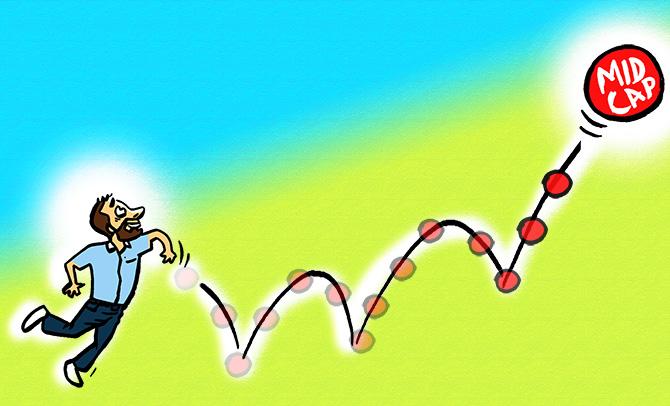Long-term investors should consider moving into smaller stocks.
Rather than try to pick stocks, it makes sense to build a diversified portfolio by exposure across midcap and small caps funds, suggests Devangshu Datta.

After NBFC (non-banking financial companies) defaults and corporate defaults, Mudra and Karvy could be the next stress points for the beleaguered economy, and for the booming stock market respectively.
In July, the government said in Parliament that, out of the 190 million loans handed out under the Mudra scheme since 2015, about 36 million loans have gone bad.
That's one out of every 5.5 loans handed out under the scheme.
In value terms, the bad loans amounted to Rs 17,250 crore in FY19, up from Rs 7,277 crore in FY18.
About Rs 9 trillion in loans have been handed out under the scheme, so the NPA ratio is still low.
By the standards of corporate defaults, this is chickenfeed.
But that's a massive 137% rise in bad loans, year-on-year.
Mudra is handed out to MSMEs with loans of up to a maximum of Rs 10 lakh handed out to non-corporate, non-farm small and micro enterprises.
The bad loans ratio -- one of every 5.5 loans defaulting -- and the fact that bad loans have risen sharply in 2018-2019 indicate stress in this key economic segment.
Given that the overall economy saw a further slowdown in April-June 2019 and, most probably in July-September 2019 as well, there's a high probability Mudra NPAs have swelled even more in the last six months.
If large corporates have poor results, the MSME sector has mounting defaults, and the government is cash-strapped and unable to increase expenditure, it is hard to see how the economy could maintain growth momentum.
However, the stock market continues to rise, on the back of strong FPI (foreign portfolio investor) buying and steady inflows from retail investors.
The FPIs brought in over Rs 20,000 crore in November and the Sensex and Nifty hit new highs.
However, the Karvy scam could be a dampener.
It depends on the dimensions of the misuse of client assets.
There are chances that Sebi's actions to stop this misuse may trigger either major selloffs, or large-scale defaults.
Neither might happen, of course, but this is a slow-burn situation. It could escalate.
Given a stock market trading at all-time highs, we would expect analyst coverage of stocks to also be at all-time highs.
However, that's not the case.
A Bloomberg report indicates that analysts are reducing coverage of even the top 500 stocks.
The Bloomberg data indicates that over a third of the BSE 500 have seen a reduction in the number of analysts covering the stock.
Analysts generally drop coverage when they can't easily make earnings projections, or when there has been a clear deterioration in the fundamentals.
As many as 48 companies in the BSE 500 universe reported losses in 2018-19.
The NBFC sector, telecom and other capital-intensive sectors have seen this reduction in coverage.
Some of the big names affected are Indiabulls Housing, Vodafone Idea, Power Grid Corporation, Dewan Housing, YES Bank, JSW Energy, etc.
In general, the move has been narrow.
A third of the Sensex 30 -- 10 stocks -- have contributed over 90% of the incremental gains since the corporate tax cut was announced.
The midcaps and small caps have also moved up, but less than the Sensex/Nifty.
The midcap and small-cap indices are trending well below their all-time highs.
Midcaps and small caps have also seen a decline in valuations, from average PEs of 40-plus a year ago, to below 30 now.
Valuations are not cheap in smaller stocks by any means.
But they are lower than in large caps.
Assuming that the rally continues, at some stage institutional investors will start looking at midcaps and small caps because of the valuation differential: Large caps will be too expensive for comfort and midcaps and small caps will start to look attractive.
Long-term investors should consider moving into smaller stocks now in anticipation of such a shift in institutional attitude.
Rather than try to pick stocks, it makes sense to build a diversified portfolio by exposure across midcap and small caps funds.
There are several small-cap funds, for instance, that have consistently returned over 14% compounded over the past five years.
But most of those funds also have negative returns in 2019-2020.
Indeed, most small cap and midcap funds have negative or low returns in 2018-2019 as well.
That pattern of losses could change, with a reversion to the long-term return.











